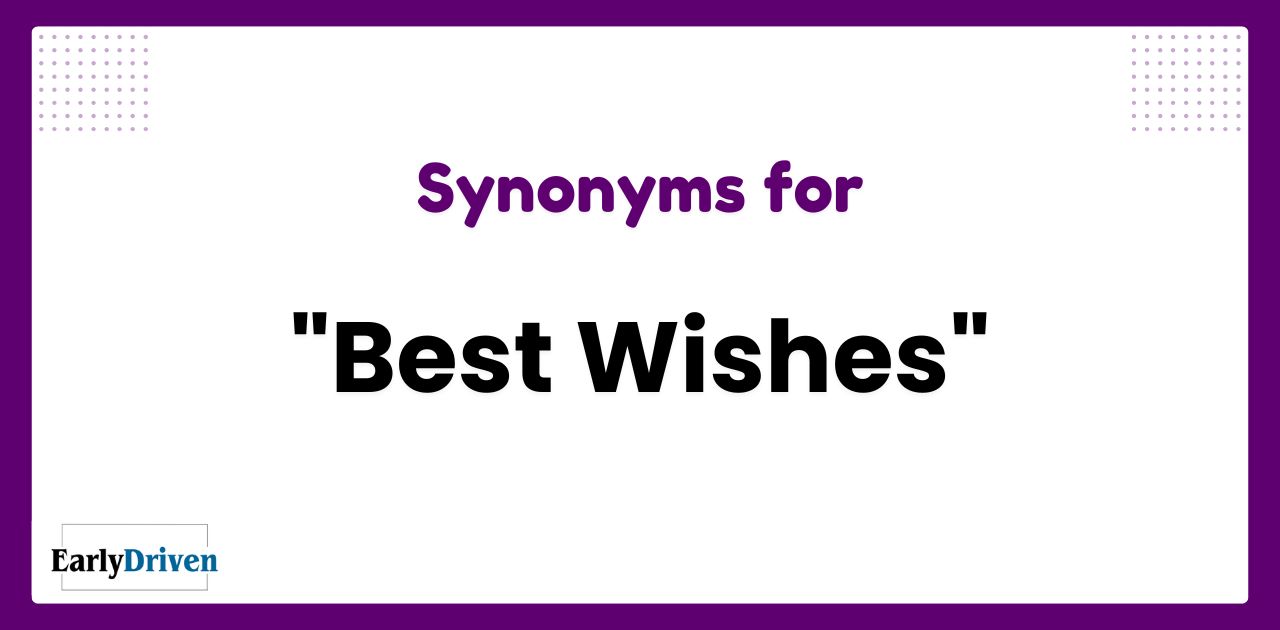In today’s digital workplace, how you end your emails can significantly impact your professional relationships. While “Best Wishes” has long been a standard email closing, modern business communication demands more nuanced and contextually appropriate sign-offs. This comprehensive guide explores twenty refined alternatives that can enhance your email etiquette and strengthen your professional correspondence.
Understanding the Purpose of Email Closings
The way we conclude our professional email greetings serves as the final impression we leave on recipients. An appropriate closing can reinforce your message’s tone, demonstrate respect, and maintain professional relationships. The key is selecting closings that align with both your relationship to the recipient and the email’s context.
Professional Ways to Close Your Business Emails: Best Wishes Alternatives
- All the Best
- Friendly Regards
- Casual Best Regards
- Formal Well Wishes
- Sincere Regards
- May You Flourish
- Professional Good Luck
- Informal Warm Regards
- Respectful Kind Regards
- Warmest Regards
- Genuine Regards
- Good Luck
- Kind Regards
- Thoughtful Wishes
- Cordial Wishes
- Honest Good Luck
- Heartfelt Good Wishes
- Polite Regards
- Authentic Best Regards
- Wishing You Success
1. All the Best
This versatile closing strikes an ideal balance between warmth and professionalism. It’s particularly effective when concluding positive communications or showing support for future endeavors.
Example: “Thank you for sharing your project proposal. All the best with the upcoming presentation to the board.”
2. Friendly Regards
When maintaining an approachable yet professional tone with regular colleagues, “Friendly Regards” offers the perfect blend of cordiality and respect.
Example: “I look forward to our team meeting next week. Friendly Regards, Sarah”
3. Casual Best Regards
This closing works well in established professional relationships where some familiarity exists while maintaining appropriate boundaries. It’s particularly suitable for internal team communications or regular business partners.
Example: “I’ve reviewed the quarterly reports and added my comments to the shared folder. Looking forward to discussing them during our next review meeting. Casual Best Regards, Michael”
4. Formal Well Wishes
In situations requiring heightened professionalism, such as communications with senior executives or important clients, “Formal Well Wishes” conveys respect and sophistication.
Example: “Thank you for considering our proposal for the upcoming infrastructure project. We look forward to the opportunity to serve your organization’s needs. Formal Well Wishes, Jennifer Thompson, Project Director”
5. Sincere Regards
This closing effectively communicates genuine interest and authenticity in professional correspondence, especially when delivering important news or responding to significant developments.
Example: “We truly appreciate your ten years of dedicated service to our organization. Your contributions have been invaluable to our growth and success. Sincere Regards, The Executive Team”
6. May You Flourish
This elegant and distinctive closing works particularly well in congratulatory messages or when expressing support for someone’s professional growth.
Example: “Congratulations on your promotion to Regional Director. Your dedication and innovative approaches have consistently impressed the leadership team. May You Flourish in your new role, David”
7. Professional Good Luck
When offering support for specific endeavors while maintaining business decorum, this closing strikes an appropriate balance.
Example: “Your presentation materials for the client meeting are thoroughly prepared. Professional Good Luck with tomorrow’s pitch, Your Marketing Team”
8. Informal Warm Regards
Perfect for ongoing business relationships where a personal connection has developed while keeping interactions professional.
Example: “Thanks for your quick response on the project timeline adjustments. I appreciate your flexibility and collaborative approach. Informal Warm Regards, Sarah”
9. Respectful Kind Regards
This closing demonstrates professional courtesy while conveying genuine consideration for the recipient. It’s particularly effective in situations requiring diplomacy or when addressing senior colleagues.
Example: “I’ve carefully reviewed your concerns about the project timeline and have prepared a detailed response addressing each point. I welcome the opportunity to discuss these adjustments during our meeting tomorrow. Respectful Kind Regards, Thomas Chen, Project Manager”
Read Also: 15 Other Ways to Say “Please Confirm Receipt”
10. Warmest Regards
When maintaining professional relationships that have developed a collegial warmth, this closing strikes an ideal balance between friendliness and business appropriateness.
Example: “Thank you for your invaluable contributions to our quarterly strategy session. Your insights about market expansion opportunities were particularly enlightening. Warmest Regards, Michelle”
11. Genuine Regards
This closing effectively communicates authenticity in professional correspondence while maintaining appropriate boundaries. It works well when providing feedback or expressing appreciation.
Example: “Your dedication to mentoring our junior analysts has made a significant impact on team performance. The growth in their analytical capabilities is a direct result of your guidance. Genuine Regards, Leadership Team”
12. Good Luck
While simple, this closing can be powerful when used appropriately, especially when supporting colleagues facing professional challenges or opportunities.
Example: “Your preparation for the certification exam has been exemplary. The entire department recognizes your commitment to professional development. Good Luck, Robert”
13. Kind Regards
This versatile closing works across various professional contexts, offering a perfect blend of courtesy and professionalism. It’s particularly effective in routine business correspondence.
Example: “I’ve attached the updated market analysis report incorporating the latest quarterly data. Please let me know if you need any clarification on the findings. Kind Regards, Amanda Torres, Market Analyst”
14. Thoughtful Wishes
When expressing support or acknowledgment of significant professional moments, this closing conveys careful consideration and genuine care.
Example: “As you transition to your new role in the Singapore office, know that your contributions to our European operations have been deeply valued. We look forward to continuing our collaboration across regions. Thoughtful Wishes, The Executive Committee”
15. Cordial Wishes
This closing maintains professionalism while adding a touch of warmth, making it ideal for building and maintaining positive business relationships.
Example: “Thank you for sharing your expertise during today’s client workshop. Your insights on digital transformation strategies were particularly impactful. Cordial Wishes, James”
16. Honest Good Luck
This closing conveys genuine support while maintaining professional standards. It’s particularly effective when acknowledging colleagues’ upcoming challenges or opportunities.
Example: “Having reviewed your presentation for tomorrow’s board meeting, I’m confident that your innovation proposal will resonate strongly with the leadership team. Your thorough research and strategic approach are evident throughout. Honest Good Luck, Catherine Wells, Innovation Director”
17. Heartfelt Good Wishes
When acknowledging significant professional milestones or expressing support during important transitions, this closing demonstrates sincere care while preserving professional boundaries.
Example: “As you embark on your sabbatical to complete your doctoral research, please know that your contributions to our research department have been invaluable. We look forward to the insights you’ll bring back to our organization. Heartfelt Good Wishes, Dr. Marcus Chen, Research Director”
18. Polite Regards
This closing serves as a reliable choice for maintaining professional courtesy in everyday business correspondence, particularly useful in communications with new contacts or formal business settings.
Example: “Thank you for your inquiry regarding our enterprise solutions. I’ve attached our comprehensive service proposal tailored to your organization’s specific requirements. Polite Regards, Elizabeth Morgan, Enterprise Solutions Specialist”
19. Authentic Best Regards
This closing effectively combines professionalism with genuine connection, making it suitable for established business relationships where trust and rapport have developed.
Example: “Your team’s collaborative approach to the cross-departmental initiative has set a new standard for project execution. The results speak volumes about your leadership. Authentic Best Regards, William Hayes, Operations Director”
20. Wishing You Success
This forward-looking closing expresses support and optimism while maintaining professional decorum, particularly effective when concluding communications about new ventures or challenges.
Example: “Your strategic vision for expanding our Asia-Pacific operations demonstrates remarkable insight and careful consideration of market dynamics. Wishing You Success in implementing this transformative initiative, Alexandra Chen, Global Strategy Officer”
Read Also: 15 Other Ways to Say “Firstly, Secondly, Thirdly”
FAQ’s
Q: What are some sophisticated alternatives to “best wishes” in professional emails?
A: Professional alternatives include “Warm Regards,” “Kind Regards,” and “Sincere Regards,” each conveying varying degrees of formality while maintaining business appropriateness.
Q: Is “best wishes” considered professional in business correspondence?
A: While “best wishes” is professionally acceptable, context matters significantly. For formal business situations, alternatives like “Kind Regards” or “Respectful Regards” may be more appropriate, especially in initial communications.
Q: How can I make my email closing more personalized while maintaining professionalism?
A: Consider adding a contextual element before your closing, such as “Looking forward to our collaboration” followed by “Warm Regards,” or reference a specific upcoming event before using your chosen closing.
Q: What are some heartfelt alternatives to “best wishes” for meaningful professional moments?
A: For significant professional occasions, consider “Sincere Best Wishes,” “Warmest Regards,” or “Cordial Wishes,” which convey genuine sentiment while maintaining professional boundaries.
Q: When should I use formal versus casual email closings?
A: Use formal closings like “Respectful Regards” or “Professional Best Wishes” with senior executives, new clients, or formal business situations. Reserve casual closings like “All the Best” for established colleagues and regular correspondents.
Q: How do you express good wishes professionally in international business correspondence?
A: In international business communication, stick to universally understood closings like “Kind Regards” or “Best Regards,” which translate well across cultures and maintain professional standards globally.
Q: What makes an email closing effective in business communication?
A: An effective business email closing should align with your relationship to the recipient, reflect the email’s purpose, maintain appropriate formality, and demonstrate professional courtesy while being concise.
Conclusion
The art of choosing appropriate email closings enhances professional communication and strengthens business relationships. These twenty alternatives to “Best Wishes” offer versatile options suitable for various business contexts and relationship dynamics. By selecting closings that align with both the message content and recipient relationship, professionals can ensure their communications conclude with appropriate courtesy and impact.
Elevate you English Learning Skills with our Mastery Blogs!

“Smith, At EarlyDriven, our dedicated team of experienced writers and journalists brings you comprehensive coverage across entertainment, celebrity news, and educational content. With expertise in digital media and a commitment to accuracy, we craft engaging stories that inform, educate, and entertain our global readership.










